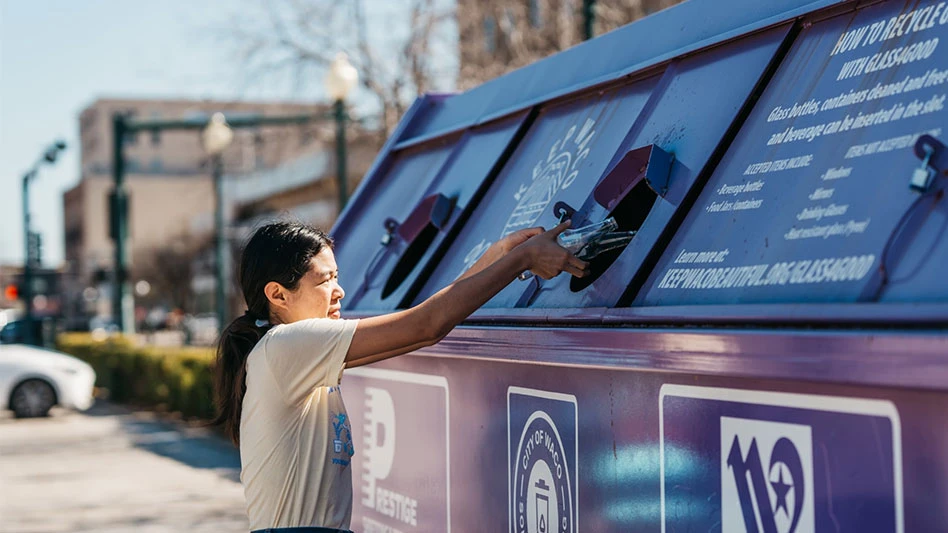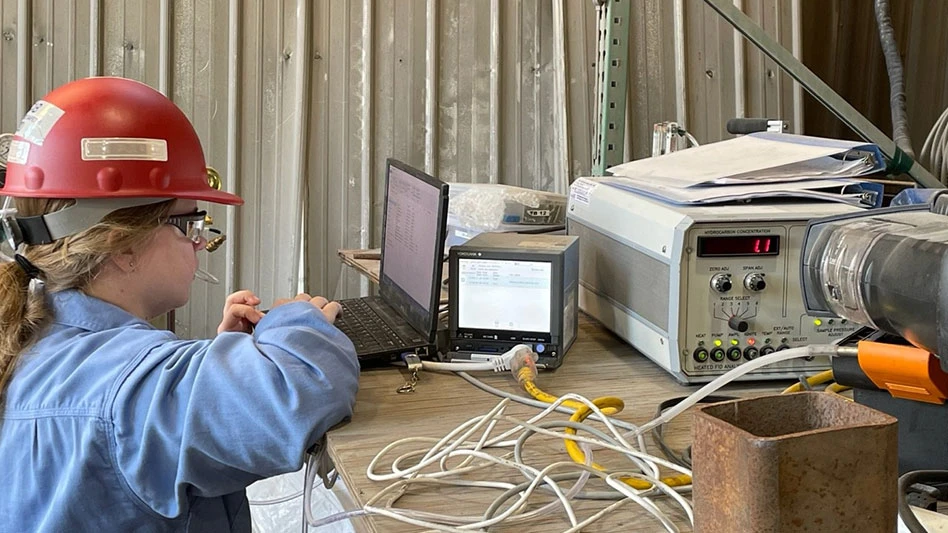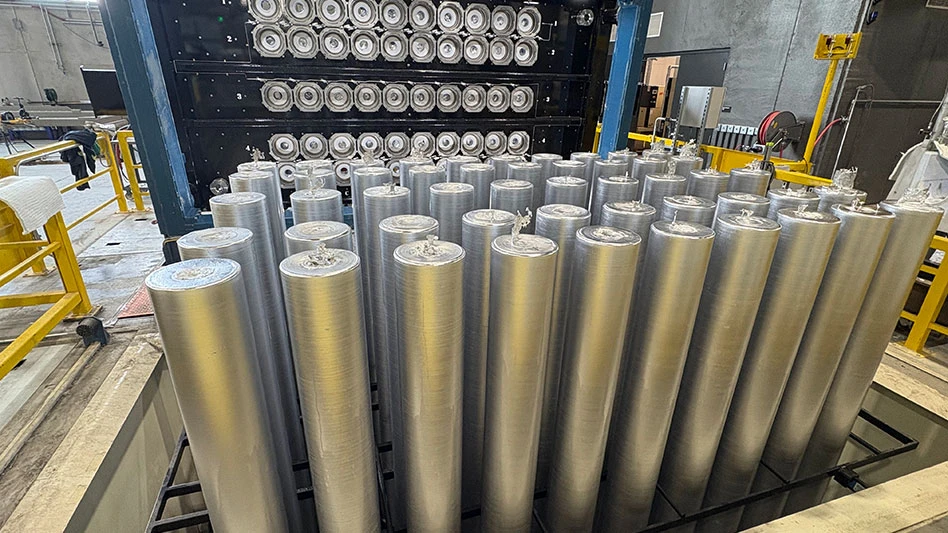Tire recyclers hope road contractors will compete with tire-derived fuel consumers to heat up the scrap tire market.
Many tire recycling advocates want the road beneath your car’s tires to be made of just that—tires. Putting effort into finding end markets for scrap tires in uses such as rubberized asphalt pavement has been taking place as piles of scrap tires are processed and make their way into the marketplace.
Applications for scrap tires such as rubberized asphalt pavement and playground coverings have recyclers cautiously saying that the future market for scrap tires could be promising.
Chipping Away at Scrap Tires
There have been varying estimates of how many scrap tires are in piles, with numbers ranging up to more than three billion. Michael Blumenthal, executive director of the Scrap Tire Management Council, Washington, says that estimate was never correct.
“There were never three billion,” he says. “Back in the early 1990s there was no data out there. Basically it was an academic strike at this issue. The simple truth is there never were three billion; there never were two billion, [but there were] about 800 million to one billion prior to 1994.”
Blumenthal cites 1994 as a significant year because that was the first year the Scrap Tire Management Council studied the issue and calculated the 800 million scrap tire figure. In 1996, and every two years after that, the council has studied the number of scrap tires in the U.S., with stockpiled scrap tires currently down to about 300 million.
There are several reasons for the declining number of scrap tires, Blumenthal says. “Factor number one is that a good number of states have good, aggressive stockpile abatement programs. Florida, North Carolina, Maryland, Illinois and Missouri have all gone out and cleaned up tires. Oregon and Minnesota have aggressively attacked their stockpiles. The first factor is aggressive state abatement programs.”
A factor Blumenthal says may have contributed to the initial inaccuracy is the failure to be able to properly count scrap tire piles. “Today we have better technicians in the field who can accurately assess the size of a pile and how many tires are actually in the pile,” he says. “Typically the piles were overestimated.”
The third factor Blumenthal says has contributed to the shrinking number has been tire fires. “There have been a number of large tire fires that wiped out a number of piles. No one believes that tire fires are a good way to address the stockpile issue,” Blumenthal says. “That is no one’s first choice.”
Although several large tire fires did eliminate high quantities of tires, the burning tires do more harm than good by creating environmental problems. “The fact that fires happen only reinforces the sense of urgency for pile abatement.”
Jim Waldron of Tri-Rinse, a St. Louis-based company that contracts to clean up and process tire stockpiles, says the number of scrap tire piles has definitely decreased. “From our standpoint, a number of states have for some time had programs that allowed them to clean up a lot of the piles,” he says.
The current recycling infrastructure is able to handle about 80 percent of the scrap tires that are now generated, he estimates. But taking care of the older piles has been a game of catch-up. “A wonderful dent has been put in those by our company and others,” Waldron says. “I don’t think there are any fewer tires [being generated], but I think the infrastructure is better and the laws more stringent.”
Tri-Rinse cleans up scrap tire piles and uses the tires mostly for civil engineering applications, such as for landfill cover. “We focus our efforts on civil engineering projects,” Waldron says. Often civil engineering applications do not require the tires to be shredded to very small pieces, thus making their use not as expensive as other applications that might require one or two-inch chips.
|
Fueling a Profit |
|
Money doesn’t grow on trees, nor has it typically been found in scrap tires. Tire recycling is seen by many as a nuisance disposal and landfill diversion effort, but significant profits arising from the activity have been elusive. GreenMan Technologies Inc., Lynnfield, Mass., is among the companies trying to establish a long-term, profitable tire recycling business. The company offers publicly traded stock to investors who decide the company has put together a workable model. What GreenMan and its CEO Bob Davis have been doing is consolidating tire recycling operations in the southeastern U.S. with the goal of becoming a reliable provider of two-inch chips to sell as tire-derived fuel and for civil engineering applications. (Among these applications, says Davis, are uses as a filtration medium in septic tank fields and landfills and as a layer in road beds.) With its most recent acquisition of Tennessee Tire Recyclers Inc., GreenMan is now processing six million passenger tire equivalents each financial quarter. More importantly, the company earned an operating profit of $477,000 in its most recent quarter. The quarter was the third consecutive profitable one for the company. “We anticipate the [fiscal] year ending September 30,2001 will be the first profitable year in GreenMan’s history,” says Davis. |
Paving the Way
There are several new projects using rubberized asphalt in Arkansas and Nebraska, says Doug Carlson, deputy director, Rubber Pavements Association, Tempe, Ariz. In Arkansas the Waste Tire District is trying to push a project for a county road that is close to breaking ground. Nebraska also has a rubberized asphalt pavement project on a highway in Lincoln ready to begin.
Carlson says a key to having a project actually take shape is having the state’s Department of Transportation (DOT) in support of the project. Nebraskans involved in the project had the support of their DOT, and Carlson says this made the project go a lot faster.
Convincing contractors and the state Departments of Transportation of the benefits of rubberized asphalt in paving applications can be a tough sell. Contractors typically do not want to experiment with the product until they have a demonstration from the DOT. “Contractors are normally the risk takers,” Carlson says. “They will invest a few dollars if they think they can make or save some money doing this. They won’t do it until they have a demonstration by the DOT. I would say that the market is really driven by the decision of the DOT.”
David Squires, president, Tire & Rubber Recyclers Inc., Ocala, Fla., agrees that rubberized asphalt is gaining ground. “The asphalt market has big potential,” he says. “It seems like the tests and installations they have done have been successful, and more asphalt companies are realizing that they need to get involved with using the rubber. Rubberized asphalt is starting to prove it does extend the life and reduce maintenance required, and as that becomes more and more proven and evident then [contractors] will be willing to spend more money.”
Some states are in front in terms of acceptance or willingness to use rubberized asphalt pavement. “Texas wants to be a leader as far as smooth pavements are concerned,” Carlson says. “The market there has grown 40 percent in the last year, but mind you, it was very small. But it is pretty substantial and you are talking a lot of tons of crumb rubber.”
Carlson says previously about 800,000 scrap tires were used each year in paving applications, but that number has risen to about 1.6 million, or higher.
Although rubberized pavement is a good end market for scrap tires, Carlson warns that not every scrap tire can potentially end up as road pavement. The components of tires continue to change, and as many as 60 different rubber materials may be used in their making. This means the properties of crumb rubber change as well, forcing contractors and processors to look at the waste stream of tires more closely to make sure it is still consistent.
“Typically the best kind of rubber to use in roads is ‘fresh’ scrap tires, because if they sit in scrap piles too long they become brittle and the rubber is less absorbent and resilient and does not interact with liquid asphalt,” Carlson says. “The optimum material for asphalt rubber is ‘fresh’ scrap tires.”
Developing Markets
Several alternative end markets for scrap tires have been emerging over the past several years, each gaining popularity. The popularity of “pour and place” playground surfaces has grown as a market for buffings, or tire pieces made during the re-treading process.
Squires says demand for the recycled material is increasing. His company provides buffings for use in playground coverings. “As far as the end markets for the buffing material, the big demand is for pour and place playground surfaces,” he says. “Pour and place is where they mix the rubber with a polyurethane binder and tromp it down like concrete. Basically it is like a spongy surface. Over top of that you can put a 5/16-inch layer of colored rubber over it.”
Squires says products such as playground coverings are gaining popularity, even though they carry a higher price tag than traditional mulches and blacktops. “It is expensive, but people like it because it is a safer alternative to mulch.”
Buffings are popular, Squires says, because the cost is substantially less than virgin rubber. “These manufacturers can cut their raw material costs down dramatically and still have the same quality and product.”
Demand for different mesh grinds can vary from region to region. He has seen demand for a fairly coarse material in the past year or two. The material is used a lot for equestrian riding rings and walking paths. “The coarser material, such as the one and two -inch chips, mostly goes to be used for fuel at cement kilns. But in Florida the latest thing to do is use it for septic tank drainage,” Squires says.
Most portraits of end markets for scrap tires find tire-derived fuel (TDF)—tire chips used in boilers and cement kilns—as far and away the leading application for scrap tires.
While the use of buffings and crumb rubber in other applications is increasing, Corny Snyder, president, JaiTire, Denver, says prices for the commodities still need to rise. “In general, markets are looking really good,” she says of those for JaiTire’s crumb rubber products, which are sold into turf treatment markets. “The price of crumb rubber still needs to rise. [Processors selling to paving contractors] are not making enough money on what they are doing. They need a 40 to 50 percent rise. Everyone is sitting on low profit margins.”
Snyder warns that when too many companies are processing scrap tires for too few end markets, it can mean disaster. “I think that right now most people will tell you that the markets are reasonably good, but that seven or eight new companies would then bring it down. We are all guarded about saying that markets are good because they need to stay good.”
If the number of processing plants doesn’t outpace the growth in crumb rubber end markets, then markets could be sustainable, Snyder says. “But it’s still tough. I watched a couple of companies consolidate and they have not been successful. They get weary when the money is not where they were told it would be. There is simply not a lot of money in this industry.”
The overall low profit margin on tire recycling makes it a difficult business to sustain at times, although Snyder says she thinks crumb rubber markets can be sustainable in the long run. “The real question is if the price of rubber is going to go high enough.”
A Promising Future
As far as the effect on the marketplace of the shrinking scrap tire piles, Blumenthal does not see that having much effect on products such as tire derived fuel for several reasons. “Number one is tire pile abatement is a function of a state program,” he says. “No one goes out and picks off a pile as part of their business plan. It is a very expensive way to get your tires and there are very limited applications for stockpile tires. Return on investment is low. That is why states have designated funds to clean them up.
“The second reason is because they typically are metered in fairly small amounts in localized areas,” he says. “And thirdly, they could only go to a couple of markets—whole tires as fuel and as a rough cut for fuel or civil engineering applications. Since the state is paying for the abatement of that pile, part of the price of remediation is getting rid of that tire. So typically they do not charge a lot for those tires.”
Waldron is not sure if his company will move toward different opportunities such as rubberized mulch. “Tires are a portion of what we do —about 35 percent of our business—and we are trying to make it smaller. We see our participation in the industry changing.”
Squire says markets for recycled rubber hold promise. “I see demand for recycled rubber material increasing because there are more and more new uses coming, and also because manufacturers and the public are becoming more aware that this material is available.”
It can be argued that the current combination of uses has not yet created a seller’s market, but some tire recyclers are hopeful that applications for scrap tires beyond fuel and landfill cover can make crumb rubber a hot commodity.

Explore the October 2001 Issue
Check out more from this issue and find your next story to read.
Latest from Recycling Today
- Motion opens new branch in Quebec
- Researchers consider recycling lottery outcomes
- Veolia plans large-scale plastics recycling facility in UK
- Ecore acquires New York tire processing firm
- Closed Loop Partners adds private equity managing director
- European Commission drafts new rules for chemically recycled content in plastic bottles
- Redwood Materials launches Redwood Energy
- Cirba Solutions announces new human resources executive





